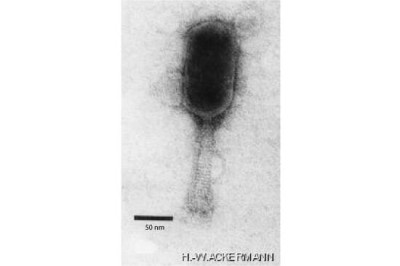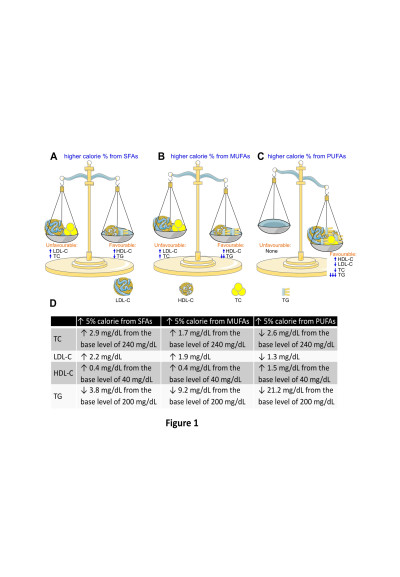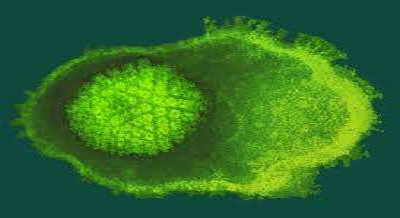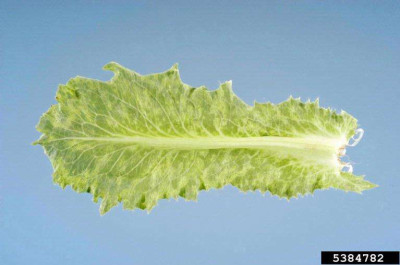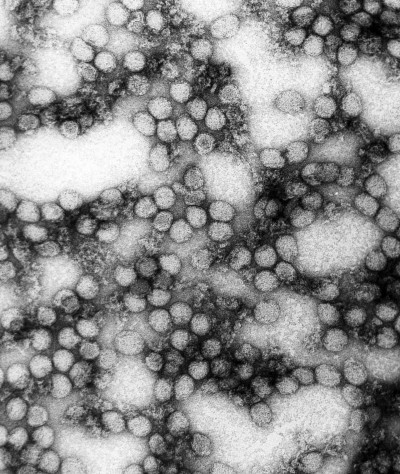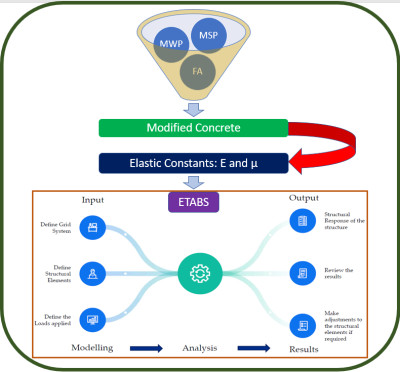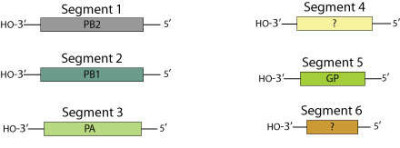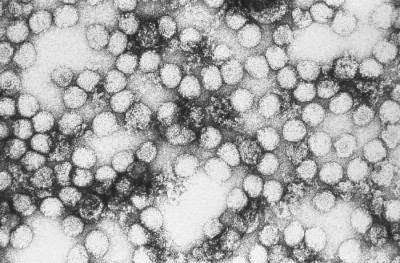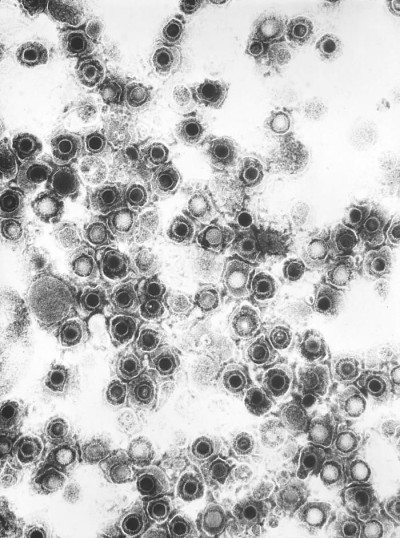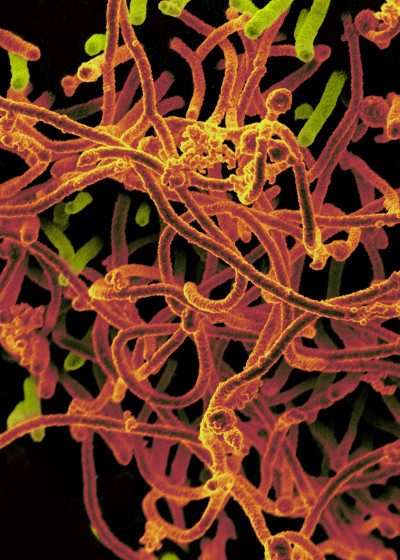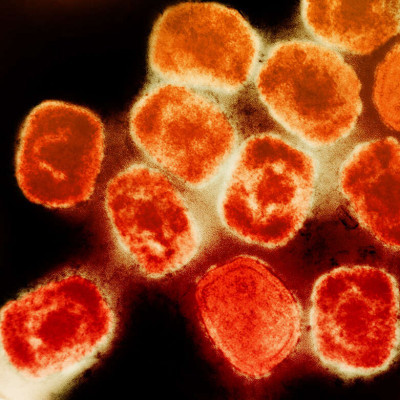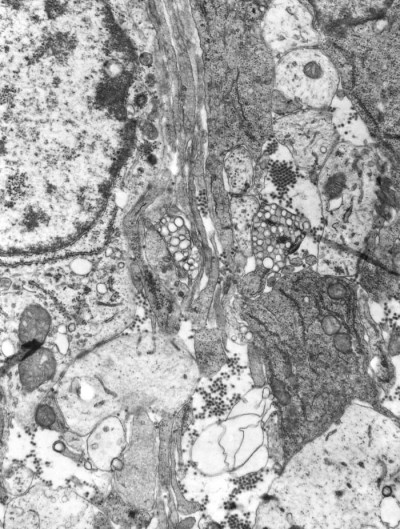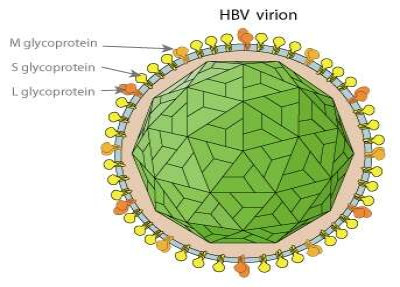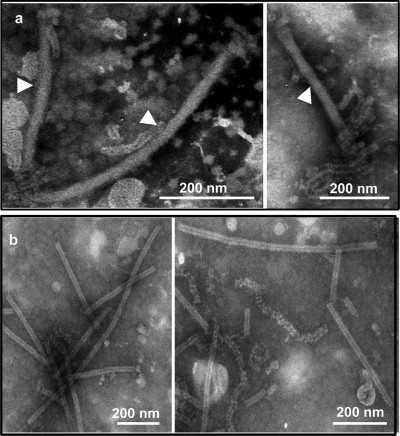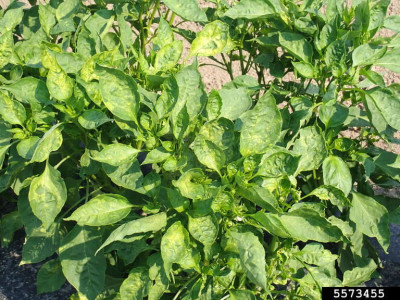Maximum likelihood phylogenetic tree of the amino acid sequences of the RNA-dependent RNA polymerase (RdRp). The virus families are color-coded and the hosts for viruses within each group are indicated in the outermost circle. The six groups are identified in the legend and the boundaries of these groups are indicated in the outer ring of the phylogeny. Group I: Peribunyaviridae, Phenuiviridae, and Cruliviridae. Group II: Fimoviridae and Tospoviridae. Group III: Hantaviridae and Phasmaviridae. Group IV: Arenaviridae and Mypoviridae. Group V: Nairoviridae and Wupedeviridae. Group VI: Phenuiviridae, Leishbuviridae, and unassigned species. Clade validation is based on the approximate likelihood ratio test (aLRT)-Shimodaira–Hasegawa (SH)-like test values. [1]
Wikimedia Commons, Herath, V., Romay, G., Urrutia, C.D., Verchot, J
01 Mar 2024
Electron micrograph of a virion of species Schizotequatrovirus. Non-enveloped, head-tail structure. The prolate head is 140 nm in length and 70 nm in width. The tail is 140 nm in length, contractile, has 6 long terminal fibers, 6 short spikes and a small base plate.
ViralZone, SIB Swiss Institute of Bioinformatics, Wikimedia Commons
01 Mar 2024
A-B, Higher usual intake of saturated fatty acids (SFAs, A) and monounsaturated fatty acids (MUFAs, B) was associated with higher low-density lipoprotein cholesterol (LDL-C), higher total cholesterol (TC), higher high-density lipoprotein cholesterol (HDL-C) and lower triglyceride (TG). C, Higher usual intake of polyunsaturated fatty acids (PUFAs) was associated with higher HDL-C, lower LDL-C, lower TC, and lower TG. D, The extent of change in lipid profile associated with a 5% higher calorie intake from fatty acids. This figure was partly generated using Servier Medical Art, provided by Servier, licensed under a Creative Commons Attribution 3.0 unported license. [1]
04 Mar 2024
Highlighted in the image is a swamp forested region in coastal Louisiana, once covered by sprawling stands of bald cypress. Salt water intrusion and increased severity of natural disasters have affected the forest regeneration and development of healthy stands leading to invasion by understory species.
11 Mar 2024
Schematic drawing of a Nodaviridae virion (cross section and side view).
ViralZone, SIB Swiss Institute of Bioinformatics, Wikimedia Commons
11 Mar 2024
Viral RNA pathways in infected cell. In a newly infected cell, polysomes translate viral RNA (vRNA, pathway 1), and it is recruited to VRCs (pathway 2). The replicated vRNA is transported to plasmodesmata to facilitate cell-to-cell movement (pathway 3). To achieve productive infection, vRNA expression continues via new rounds of translation/replication (pathway 4). Host cell defense mechanisms leading to RNA degradation actively compete for vRNA substrates with viral counterdefense mechanisms (pathway 5). vRNA encapsidation completes the infection cycle (pathway 6), allowing the encapsidated virus to be transported and infect neighboring healthy plants.[1]
Kristiina Mäkinen and Anders Hafrén, Wikimedia Commons
14 Mar 2024
Symptoms of Bidens Mottle Virus (Potyvirus BiMoV).
Jeffrey W. Lotz, Florida Department of Agriculture and Consumer Services, Bugwood.org, Wikimedia Commons
14 Mar 2024
This photomicrograph depicts numerous yellow fever virions, under a magnification of 234,000X.
CDC/ Erskine Palmer, Public Health Image Library (PHIL), Wikimedia Commons
15 Mar 2024
This flowchart illustrates the process of modifying concrete using industrial by-products—marble waste powder (MWP), marble slurry powder (MSP), and fly ash (FA)—to improve its mechanical properties, specifically its elastic constants E (Young's modulus) and μ (Poisson's ratio). The enhanced concrete mixture is then analyzed using ETABS software, a widely-used tool in structural engineering, which simulates the behavior of building systems under various loads. Inputs such as grid systems, structural elements, and load definitions are processed to analyze the structural response. The results facilitate adjustments to improve the structure's performance, thereby contributing to sustainable and resilient construction practices.
01 Apr 2024
Quaranjavirus genome map.
Wikimedia Commons, ViralZone, SIB Swiss Institute of Bioinformatics
01 Apr 2024
Yellow fever virus virions (each 40-60 nm diameter); this virus is transmitted by mosquitos, notably by Aedes aegypti.
CDC Public Health Image Library (PHIL)/ Erskine Palmer
02 Apr 2024
This negatively-stained transmission electron micrograph (TEM) revealed the presence of numerous herpes simplex virions, members of the Herpesviridae virus family. There are two strains of the herpes simplex virus, HSV-1, which is responsible for cold sores, and HSV-2, which is responsible for genital herpes. At the core of its icosahedral proteinaceous capsid, the HSV contains a double-stranded DNA linear genome.
Public Health Image Library
02 Apr 2024
Ebola virus isolated in November 2014 from patient blood samples obtained in Mali. The virus was isolated on Vero cells.
Wikimedia Commons, NIAID
02 Apr 2024
Colorized transmission electron micrograph of monkeypox virus particles (orange) cultivated and purified from cell culture. Image captured at the NIAID Integrated Research Facility (IRF) in Fort Detrick, Maryland.
Wikimedia Commons, NAID
07 Apr 2024
At a magnification of 1000X, this scanning electron micrograph (SEM) revealed some of the minute exoskeletal details found at the proboscis tip of an unidentified mosquito found deceased in the suburbs of Decatur, Georgia. The proboscis is the organ used by this, as well as other like insects, to feed upon the blood of a warm-blooded host, including human beings. What you see here, is the sheath that encases a pair of needle-sharp "stylets", which together are known as the "fascicle". The larger of the two stylets, known as the "labrum", when viewed in cross-section, takes on the shape of a "V", and acts as a gutter, which directs the ingested host blood towards the insect's mouth. The hair-like structures are known as "setae", and are really extensions of the insect's exoskeletal, chitinous covering. These setae act as sensory organs, transmitting impulses indicating changes in the organism's environment.
Public Health Image Library
11 Apr 2024
This transmission electron micrograph (TEM) revealed the presence of a number of Eastern Equine Encephalitis (EEE) virus virions in this specimen of central nervous system tissue.
Public Health Image Library
11 Apr 2024
Hepatitis B, a liver infection triggered by the hepatitis B virus (HBV), can be prevented through vaccination. Transmission occurs when bodily fluids like blood, semen, or others from an infected individual enter the system of an uninfected person. This transmission route includes sexual contact, needle sharing, or during pregnancy and childbirth.
Wikimedia Commons, ViralZone, SIB Swiss Institute of Bioinformatics
18 Apr 2024
Morphology and structure of virions and nucleoprotein–RNA complexes (RNPs) of Sclerotinia sclerotiorum negative-stranded RNA virus 1. (a) Filamentous, possibly enveloped virions (marked by white triangles, left) and ribonucleoprotein (RNP) complexes (right). (b) Purified tight (left) or loose (right) coils of RNP complexes. [1]
Dàohóng Jiāng, María A. Ayllón, Shin-Yi L. Marzano3, and ICTV Report Consortium
18 Apr 2024
Symptoms on chili peppers Image type: Field Host: pepper (Capsicum annuum L.).
Wikimedia Commons, Whitney Cranshaw, Colorado State University, Bugwood.org
23 Apr 2024
 Encyclopedia
Encyclopedia

